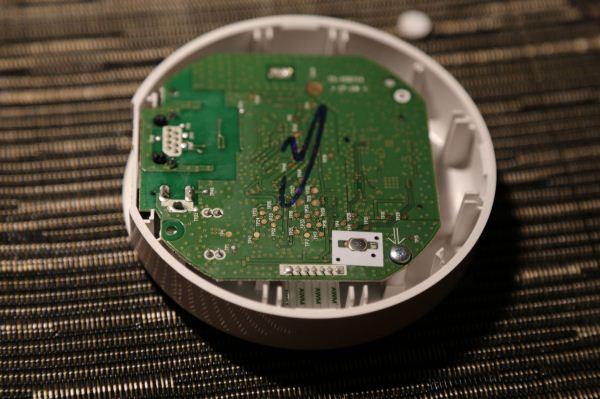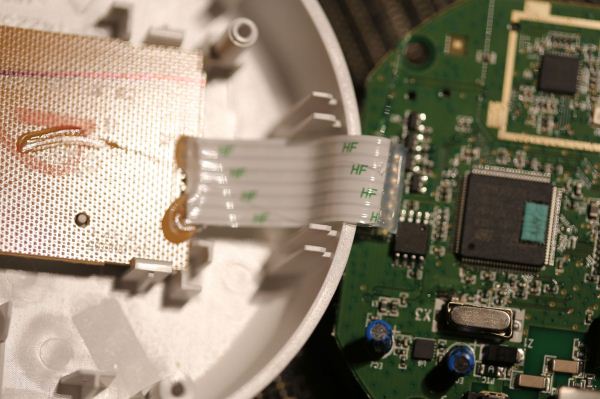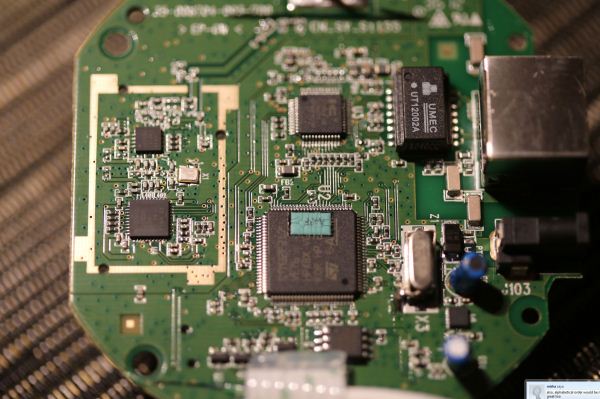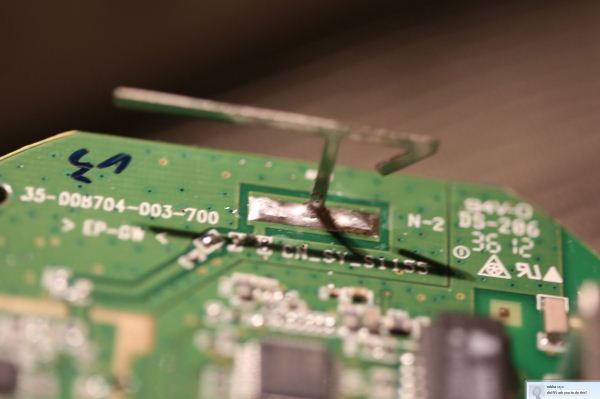Philips Hue: Automated Home Lighting Gets Colorful
by Ashu Joshi on March 1, 2013 12:50 AM EST- Posted in
- Gadgets
- Home Automation
- Philips
- Hue
- Lighting
Teardown and Design
The Hue Bridge has two screws that you need to remove before you can pop off the back. Even with the screws out, popping the back off is tricky—it has an interesting snap-in mechanism. Here’s what the back looks look like; the two white “feet” at the bottom are covering the screws. I used tools from iFixIt to get this open.
Once you open it up, you can see the back side of the PCB, and the snap-in connecter I mentioned earlier.
The PCB is connected to the front of the Bridge using a ribbon connector. This cable provides the power and signals for the LEDs and the Link button.
The main PCB has the two primary components of the Hue Bridge, an ST Microelectronics STM32F217VE Microcontrollerand a Texas Instruments CC2530 ZigBee Controller.
There is also an RF range extender (CC2590) coupled to the CC2530. The STM MCU has an integrated Ethernet controller, but as a whole the design has very few components. It’s clear that the majority of the cost for the Starter Pack is in the bulbs and not in the Bridge. (Based on the total kit price, the Bridge is $20 more than the cost of the three bulbs, though of course that leaves plenty of room for profit margins.) The image below shows the antenna for ZigBee:
I’ll cover the technology behind the Hue Bridge in a moment, but the choice of microcontroller for this design is a clear indication that this is primarily a purpose-built device. That is, it does not have the horsepower to extend to different types of applications due to the limitations of the CPU and the amount of memory. Nonetheless, it is well suited for the function at hand; let’s look at the specifics of the technology behind Hue before we get into a discussion of what it can and cannot do.





















94 Comments
View All Comments
CeriseCogburn - Monday, March 4, 2013 - link
I didn't see any whining and complaining about LUXURY item or product ?!What's going on here ?
Did our usual crybaby posting crew defer their usual stank to a knee jerk reflexive Apple muzzle worship ? I doubt that - maybe they just brainfarted out.
glugglug - Monday, March 4, 2013 - link
The extra weight is normal for LED lights, programmable or not, as LEDs don't work as well when they get hot, so LED light bulbs have hefty heatsinks.A decent LED bulb goes for $30-$40, especially if you try to get a warm white close to incandescent color instead of the typical painful bluish, so $60 for color adjustable LEDs is actually quite reasonable.
In areas like NYC where the ConEd prices are highway robbery at face value, and they multiply that by claiming you use several times more than you do, a $60 LED bulb can pay for itself in 2 months if you use it 24-7.
wiyosaya - Monday, March 4, 2013 - link
Philips was already in home automation before this with their Pronto remotes. They got out of that due to lack of profitability a bit over a ago year now.While home automation is nice, I personally do not see the need for lights that change color. For people who experience seasonal affective disorder, this package might be the worst thing that they could do for themselves as "daylight" light sources are the best for them.
IMHO, the changing color aspect is marketing bling that Philips is adding to a high-priced product to market it to the masses. As I see it, the price of this product resides in the cost of the LED lights. One might be able to find a simpler and lower cost home automation starter kit, and then put LED bulbs in where they make sense - this approach, however, would abandon the changing color LEDs which may be of little use to most people anyway other than for novelty uses.
glugglug - Tuesday, March 5, 2013 - link
1. Instead of the LED approximation of a standard light bulb (which they do poorly due to the heatsink affecting the form factor), make the bulbs available in PAR30 or other PAR form factors, which LEDs exel in, and which is typically used for recessed ceiling lighting for a greater effect on room ambiance.2. Provide an API for controlling them which can be integrated into an Windows audio filter driver or WMP visualization for the full disco effect.
If both of those were in place, I'd probably get 15 of the bulbs for my basement.
shriganesh - Thursday, March 7, 2013 - link
What a nice and detailed and clean article! Thanks a lot Ashu Joshi! Keep up the great work. I never thought of the neighbor's commands interfering with ours!sotoa - Thursday, March 7, 2013 - link
Can these be used outside? Like to light up the front porch? For example, I can see changing the lights to Green for St. Patrick's Day, or Orange for Halloween, etc. What do you think?Are these bulbs equivalent to a 60 watt incadescent? I wasn't quite clear on that.
Velocialume - Thursday, March 7, 2013 - link
So this is the third review I've read for the Hue system.. I'm about to purchase it, but I can't seem to find confirmation that you can in fact, have the bulbs cycle colors autonomously. I really like the idea of having a sort of dreamscape type room with each bulb gradually changing color every few minutes.Either I'm blind or inattentive, but I haven't seen this feature mentioned in any review. Is this possible?
Ualdayan - Monday, March 11, 2013 - link
While I researched them like you are doing (I went ahead and ordered some btw) I found that they basically respond to HTTP POST commands (that's what he meant by open source). That means a simple javascript running on one of your computers could cycle through the different colors on all the lights for you. Take a look at every hue for ideas. (Funky comment system claimed it was spam when I tried to type the URL in an easily clickable link for you)mgc8599 - Tuesday, March 12, 2013 - link
The power consumption figures seem incorrect to me. Kill-A-watt is showing current reading as 0.08 to 0.09 amps so the power draw should be (0.08*110=8.8 w or 0.09*110 = 9.9 w) and not 5.4 w which gives 60 to 67.5 volts. also in off state the power draw will be (0.01*110=1.1 w or 0.02*110=2.2 w) and not 0.4 w as written because it gives 20-40 volts.random2 - Thursday, March 14, 2013 - link
"...they’re quite a bit heavier than a typical light bulb. Most likely the added weight comes from the controller and antenna necessary to talk to the network, and possibly the addition of multi-colored LEDs adds a bit as well..."If this has already been posted in the comments my apologies.
I believe these are heavy in part because household 120v current needs to be stepped down to a DC supply for these LED lamps. meaning each lamp has a transformer.